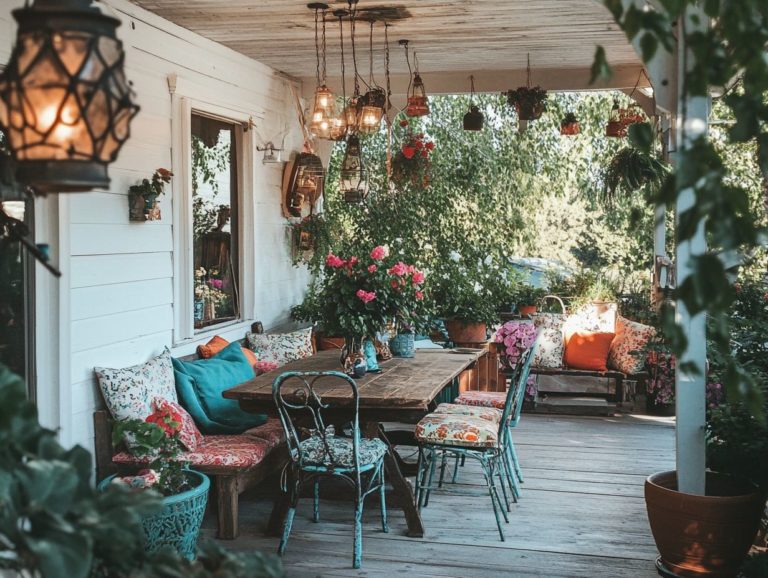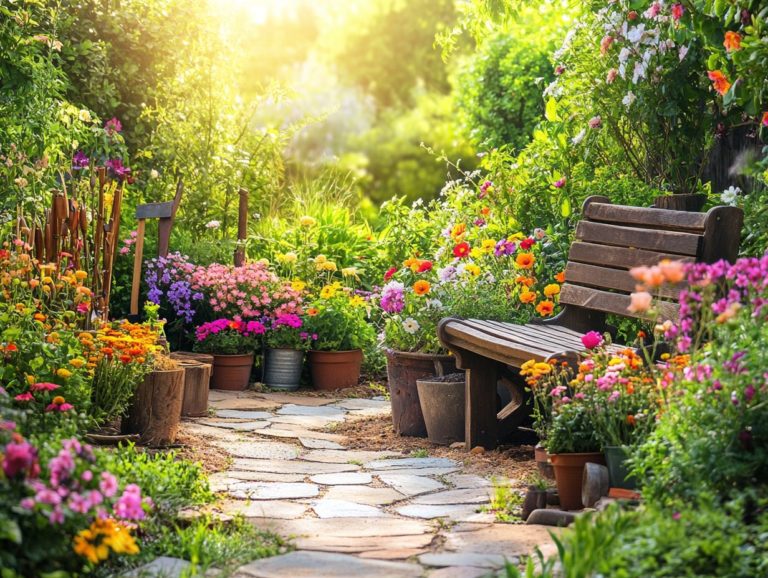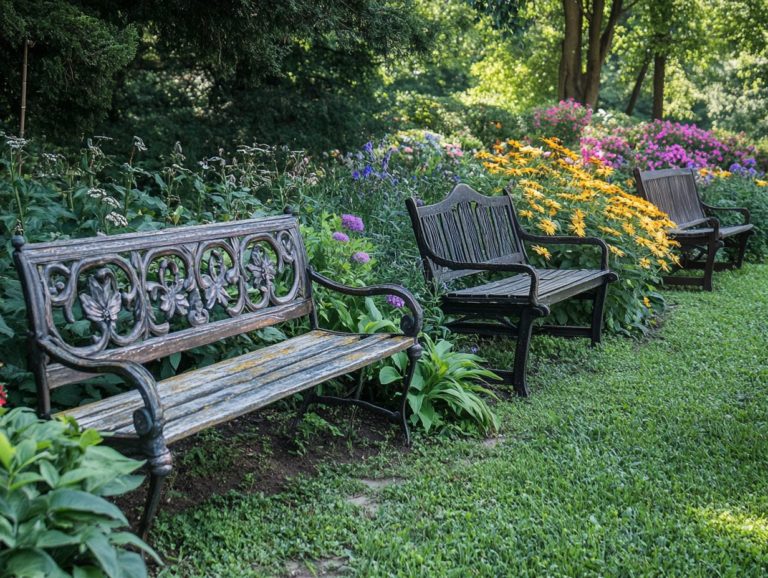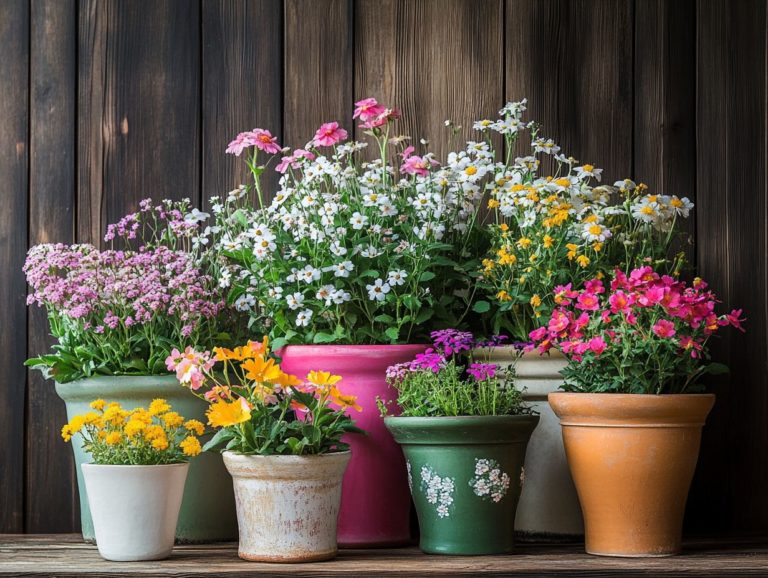Creating a Vintage Herb Garden with Style
Imagine stepping into a garden that captures the enchanting charm of days gone by, where fragrant herbs elevate your culinary creations and enrich the ambiance of your home.
A vintage herb garden beautifully merges nostalgia with practicality, providing a delightful space for you to cultivate both traditional and unique varieties.
Consider how to select the perfect location, design with a touch of vintage flair, choose the best herbs, and care for your flourishing garden.
Uncover creative ways to incorporate your harvest, crafting a timeless herb garden that seamlessly brings the past into your present!
Contents
- Key Takeaways:
- Choosing the Right Location
- Designing Your Vintage Herb Garden
- Best Herbs for a Vintage Herb Garden
- Caring for Your Vintage Herb Garden
- Unleash the Potential of Your Herbs!
- Troubleshooting Common Issues
- Frequently Asked Questions
- What are some vintage elements I can incorporate into my herb garden?
- What types of herbs are best for a vintage herb garden?
- How can I add a touch of style to my vintage herb garden?
- Do I need a large space to create a vintage herb garden?
- What are some creative ways to use herbs from my vintage herb garden?
- How do I maintain a vintage herb garden?
Key Takeaways:
- Create a vintage herb garden by incorporating unique elements, traditional herbs, and placing it in the right location that factors in sunlight, drainage, and space.
- Maintain your vintage herb garden with regular care and harvesting, using herbs in creative ways in your home and cooking to add style and flavor.
- Prevent and troubleshoot common issues in your vintage herb garden, such as pests and diseases, to ensure a flourishing and stylish garden all year round.
What is a Vintage Herb Garden?
A vintage herb garden is your ticket to a charming and nostalgic outdoor space where you can cultivate delightful varieties of herbs both culinary and medicinal. This style instantly brings peace and joy to your outdoor space, inviting you into an atmosphere infused with the soothing scents of aromatic plants.
In your garden, you ll likely find not only popular herbs like basil, rosemary, and thyme but also lesser-known gems such as lemon balm and hyssop. These enhance both the beauty and functionality of the space. The layout often boasts vintage touches, including stone pathways, rustic wooden planters, and antique garden tools, all contributing to that timeless allure.
Beyond merely pleasing the eye, this garden supports a variety of plants and insects. It attracts helpful insects, making it a vibrant and eco-friendly addition to any outdoor setting. With its perfect blend of beauty and practicality, a vintage herb garden is an ideal retreat for both novice gardeners and seasoned herbalists alike.
Choosing the Right Location
Choosing the perfect spot for your vintage cottage garden is essential for the flourishing growth of your herbs and plants. This location should offer abundant sunlight, easy access to water, and shelter from harsh winds and extreme temperatures.
A well-chosen area boosts the garden s charm and helps your plants thrive, creating a supportive environment for your herb garden.
Factors to Consider
When choosing the perfect spot for your vintage herb garden, carefully consider factors like sunlight exposure, accessibility to a water feature, and the overall layout of your outdoor space. These elements are key to creating the ideal growing conditions for your plants.
Sunlight plays a crucial role, as different herbs have distinct needs. For example, basil and oregano bask in full sun, while parsley prefers a bit of partial shade. Adequate exposure not only promotes healthy growth but also enhances the flavor of your herbs.
Incorporating a water feature, such as a tranquil pond or an elegant fountain, can work wonders for maintaining humidity levels and creating a small area with its own weather conditions that nurtures thriving plants. The gentle sound of flowing water adds an element of tranquility, transforming your garden into a peaceful retreat.
To complement that vintage aesthetic, think about adding decorative grills. They serve practical purposes, like supporting climbing plants or defining spaces, while also infusing your garden with timeless charm.
Designing Your Vintage Herb Garden
Designing your vintage herb garden calls for a careful balance of aesthetics and functionality. Each element, from the enchanting cottage garden layout to the repurposed planters, contributes significantly to crafting an outdoor space that radiates vintage charm.
By integrating unique planters and delightful garden statues, you can create a space that not only thrives as a productive herb garden but also transforms into a serene retreat for relaxation.
Don’t wait start planning your vintage herb garden today for a bountiful harvest!
Incorporating Vintage Elements
Incorporating vintage elements into your herb garden can transform it into a unique and picturesque setting. Thoughtful selections from antique shops and flea markets, along with carefully chosen garden statues that echo vintage design aesthetics, can work wonders.
Act now! Grab weathered terracotta pots to boost your garden’s charm. These not only add rustic appeal but also provide excellent drainage for your herbs.
Vintage watering cans crafted from zinc or brass serve practical purposes while doubling as delightful decorative accents, infusing a touch of nostalgia into the space.
For aesthetic flair, an ornate wrought iron trellis can enhance your vertical space, providing support for climbing herbs like basil or thyme. Each carefully curated piece contributes to a cohesive narrative, creating a serene retreat that beckons relaxation and celebrates organic beauty.
Best Herbs for a Vintage Herb Garden
Choosing the right herbs for your vintage herb garden is crucial for crafting a diverse and functional space. Consider options such as culinary, medicinal, and cosmetic herbs to elevate your gardening experience and support local pollinators.
Traditional and Unique Varieties
Imagine cultivating a vintage herb garden where you blend traditional herbs like basil and thyme with unique varieties such as pineapple sage. This combination creates a visually striking and diverse garden that serves multiple purposes, from delicious meals to healing properties.
Not only does this mix enhance the aesthetic charm of your garden, but it also promotes biodiversity, enriching the surrounding ecosystem. By incorporating herbs like lemon balm, celebrated for its calming properties, alongside the vibrant marjoram, you can enjoy both flavor and therapeutic benefits.
Choosing varieties that thrive in your specific climate ensures a sustainable herb garden. Their diverse applications open up a wealth of opportunities for experimentation, whether in your kitchen or apothecary.
By thoughtfully integrating these elements, you create a nurturing environment for both the plants and yourself, fostering a truly rewarding gardening experience.
Caring for Your Vintage Herb Garden
Caring for your vintage herb garden requires a commitment to regular maintenance and thoughtful harvesting techniques. This approach ensures your plants thrive and remain productive while cultivating a stunning outdoor space that entices beneficial pollinators.
Tips for Maintenance and Harvesting
Effective maintenance and harvesting techniques are essential for maximizing the yield and longevity of your vintage herb garden. This allows both your culinary and medicinal herbs to flourish against a backdrop of exquisite garden statues and pollinator-friendly plants.
Pay close attention to the specific needs of various herb types like the sun-loving basil or the shade-tolerant mint. Cultivating these creates an enchanting environment that elevates aesthetic appeal and promotes healthy growth.
Regularly trimming your herbs encourages bushier plants and enhances their robust flavors. A thoughtful watering schedule, tailored to the unique moisture needs of each variety, keeps the leaves lush and thriving.
During the harvesting season, using sharp shears to snip sprigs minimizes disruption and encourages new growth. This ensures your herb garden remains a vibrant tapestry of life and flavor throughout the year.
Unleash the Potential of Your Herbs!
Utilizing the herbs from your vintage garden unveils a realm of creative possibilities. Seamlessly incorporate culinary, medicinal, and cosmetic herbs into various facets of your daily life.
These herbs can make your meals tastier and enhance your wellness rituals. They also elevate the aesthetic appeal and functionality of your outdoor space, transforming it into a vibrant sanctuary of beauty and utility.
Start your vintage herb garden today and bring your culinary dreams to life!
Creative Ways to Incorporate Herbs into Your Home and Cooking
Incorporating culinary herbs into your home cooking not only enhances flavor but also opens up delightful opportunities for using cosmetic herbs in homemade skincare or herbal remedies.
Consider the invigorating basil pesto that elevates pasta dishes! You might also try lavender-infused facial toners that calm your skin your options are vast and wonderfully creative.
Add lemon balm for a refreshing drink, and use its soothing properties to craft your own homemade balm to alleviate stress.
Imagine making herb-infused oils with rosemary or thyme. They enhance culinary creations and double as luxurious massage oils, nourishing and hydrating your skin.
Embracing herbs in such a multifaceted way can truly transform your everyday routines. Cooking and self-care become enjoyable and aromatic experiences!
Troubleshooting Common Issues
Addressing common issues like pests and diseases in your vintage herb garden is crucial for ensuring the health and productivity of your plants. This is particularly important when employing techniques that attract pollinators and using raised garden beds to promote effective drainage.
Take these steps to create a thriving environment for your herbs.
Dealing with Pests and Diseases
Managing pests and diseases in your vintage herb garden can be easy when you embrace organic methods. These approaches protect your plants while cultivating a thriving ecosystem that benefits pollinator-friendly flora.
Utilize techniques like companion planting growing beneficial plants together and introduce beneficial insects to naturally regulate pest populations. For example, adding flowers that attract ladybugs or lacewings can dramatically reduce aphid infestations.
Engaging in crop rotation and enriching your soil with compost are essential strategies that strengthen your plants against diseases. Focus on natural balance to protect your vintage herb garden and foster biodiversity.
These sustainable practices allow a variety of organisms to coexist harmoniously while minimizing the need for synthetic chemicals.
Frequently Asked Questions
What are some vintage elements I can incorporate into my herb garden?
You can add vintage elements like metal watering cans, antique planters, and vintage signs to give your herb garden a rustic, charming feel.
What types of herbs are best for a vintage herb garden?
Herbs such as lavender, rosemary, thyme, and sage have been used for centuries. They provide a nostalgic touch perfect for a vintage herb garden.
How can I add a touch of style to my vintage herb garden?
Add style by using unique containers, vintage-inspired labels, and arranging herbs in visually appealing patterns, like spirals or geometric shapes!
Do I need a large space to create a vintage herb garden?
No! You can create a vintage herb garden in any size space, whether it’s a small balcony or a large backyard. Use containers or vertical space to maximize your growing area.
What are some creative ways to use herbs from my vintage herb garden?
Get excited! You can use herbs for cooking, making herbal teas, creating potpourri, or even making homemade beauty and cleaning products. Experiment with different uses for your herbs!
How do I maintain a vintage herb garden?
Water your herbs regularly and ensure they get plenty of sunlight. Fertilize occasionally and trim any overgrown herbs to keep your garden tidy and thriving.





